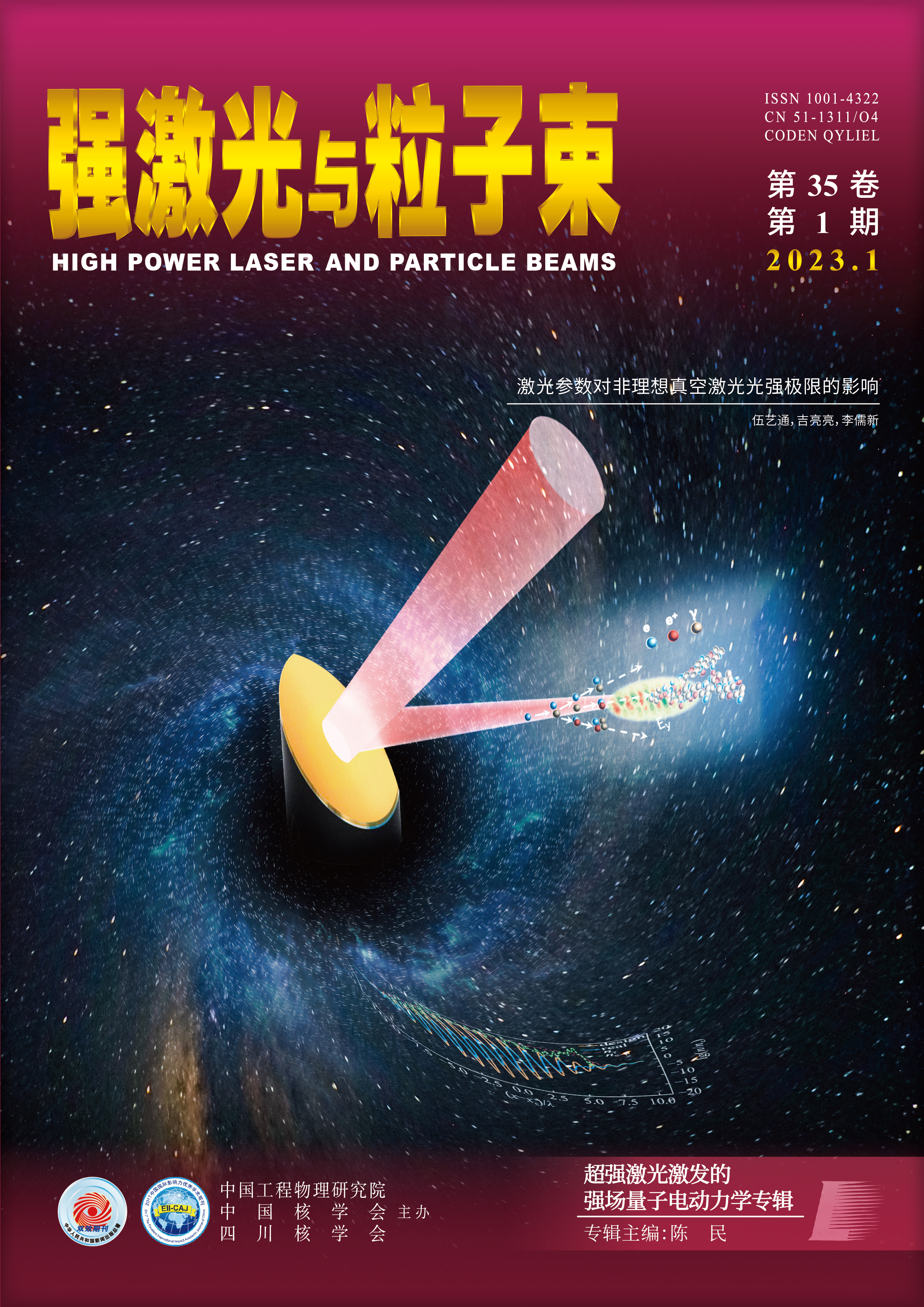2023 Vol. 35, No. 1
Recommend Articles
2023, 35: 012002.
doi: 10.11884/HPLPB202335.220145
2023, 35: 012012.
doi: 10.11884/HPLPB202335.220197
Display Method:
2023,
35: 1-2.
2023,
35: 012001.
doi: 10.11884/HPLPB202335.220215
Abstract:
The attainable upper limit of the laser intensity is a key concern in strong-field quantum electrodynamics (QED). For non-ideal vacuum conditions, the extreme laser fields interacting with the residual electrons could trigger QED cascade—the processe...
The attainable upper limit of the laser intensity is a key concern in strong-field quantum electrodynamics (QED). For non-ideal vacuum conditions, the extreme laser fields interacting with the residual electrons could trigger QED cascade—the processe...
2023,
35: 012002.
doi: 10.11884/HPLPB202335.220145
Abstract:
With the rapid development of laser technology and the continuous improvement of laser intensity, the process of electron-positron pair creation in vacuum under super strong external field, namely the process of energy conversion to mass, has become ...
With the rapid development of laser technology and the continuous improvement of laser intensity, the process of electron-positron pair creation in vacuum under super strong external field, namely the process of energy conversion to mass, has become ...
2023,
35: 012003.
doi: 10.11884/HPLPB202335.220066
Abstract:
Enhancement of nonlinear chirped frequency on electron-positron pair creation in the potential well is studied by the computational quantum field theory. The density, number and energy spectrum of electrons created under a single oscillating potentia...
Enhancement of nonlinear chirped frequency on electron-positron pair creation in the potential well is studied by the computational quantum field theory. The density, number and energy spectrum of electrons created under a single oscillating potentia...
2023,
35: 012004.
doi: 10.11884/HPLPB202335.220208
Abstract:
With the advent of ultra-short ultra-intense laser pulses, the interaction between light and matter enters the nonlinear physics regime dominated by radiation damping and quantum electrodynamics (QED) effects. The strong-field QED effects contain a w...
With the advent of ultra-short ultra-intense laser pulses, the interaction between light and matter enters the nonlinear physics regime dominated by radiation damping and quantum electrodynamics (QED) effects. The strong-field QED effects contain a w...
2023,
35: 012005.
doi: 10.11884/HPLPB202335.220216
Abstract:
Laser driven positron source has the advantages of high yield, short pulse width and high energy. In this paper, particle-in-cell simulation and Monte-Carlo simulation are combined to simulate the process of positron production in the interaction of ...
Laser driven positron source has the advantages of high yield, short pulse width and high energy. In this paper, particle-in-cell simulation and Monte-Carlo simulation are combined to simulate the process of positron production in the interaction of ...
2023,
35: 012006.
doi: 10.11884/HPLPB202335.220222
Abstract:
With the continuous development of technology, the laser power has exceeded 10 PW. The interaction between such intense laser pulse and matter enters the near quantum electrodynamics (QED) regime. From the non-relativistic laser pulse, relativistic o...
With the continuous development of technology, the laser power has exceeded 10 PW. The interaction between such intense laser pulse and matter enters the near quantum electrodynamics (QED) regime. From the non-relativistic laser pulse, relativistic o...
2023,
35: 012007.
doi: 10.11884/HPLPB202335.220204
Abstract:
Nonlinear Compton scattering is one of the dominant processes in future ultra-short ultra-intense laser-matter interactions. Today, most related researches are based on the mainstream model of nonlinear Compton scattering, which assumes short radiati...
Nonlinear Compton scattering is one of the dominant processes in future ultra-short ultra-intense laser-matter interactions. Today, most related researches are based on the mainstream model of nonlinear Compton scattering, which assumes short radiati...
2023,
35: 012008.
doi: 10.11884/HPLPB202335.220375
Abstract:
The interaction between an ultra-intense laser pulse and a relativistic electron beam is the main experimental method of strong-field quantum electrodynamics (QED). However, how to measure the accuracy of laser-electron-beam interaction, and then rea...
The interaction between an ultra-intense laser pulse and a relativistic electron beam is the main experimental method of strong-field quantum electrodynamics (QED). However, how to measure the accuracy of laser-electron-beam interaction, and then rea...
2023,
35: 012009.
doi: 10.11884/HPLPB202335.220229
Abstract:
In the past decades, great progress has been made in laser wakefield acceleration of electron beam inspired by ultra-short intense lasers in plasma. The high-energy electron beam obtained by this method can be applied to the generation of the high-br...
In the past decades, great progress has been made in laser wakefield acceleration of electron beam inspired by ultra-short intense lasers in plasma. The high-energy electron beam obtained by this method can be applied to the generation of the high-br...
2023,
35: 012010.
doi: 10.11884/HPLPB202335.220114
Abstract:
Spin-polarized plasma induced by the radiative spin flips in ultrarelativistic laser-matter interaction attracts great attention. Spin-polarized electron beams are broadly utilized in probing the structure of solid-state materials, exploring nucleon ...
Spin-polarized plasma induced by the radiative spin flips in ultrarelativistic laser-matter interaction attracts great attention. Spin-polarized electron beams are broadly utilized in probing the structure of solid-state materials, exploring nucleon ...
2023,
35: 012011.
doi: 10.11884/HPLPB202335.220209
Abstract:
Warm dense matter is an important stage of material development in the process of inertial confinement fusion and the evolution of the universe. As the density increases, quantum effects gradually manifest, and the collective excitations in warm dens...
Warm dense matter is an important stage of material development in the process of inertial confinement fusion and the evolution of the universe. As the density increases, quantum effects gradually manifest, and the collective excitations in warm dens...
2023,
35: 012012.
doi: 10.11884/HPLPB202335.220197
Abstract:
Methods, as well as challenges, in experimental studies on Hawking-Unruh radiation (HUR) with high-intensity laser (HIL) will be reviewed in this paper. Hawking-Unruh radiation is one of the most important effects in quantum gravity. Experimental stu...
Methods, as well as challenges, in experimental studies on Hawking-Unruh radiation (HUR) with high-intensity laser (HIL) will be reviewed in this paper. Hawking-Unruh radiation is one of the most important effects in quantum gravity. Experimental stu...




 Email alert
Email alert RSS
RSS

